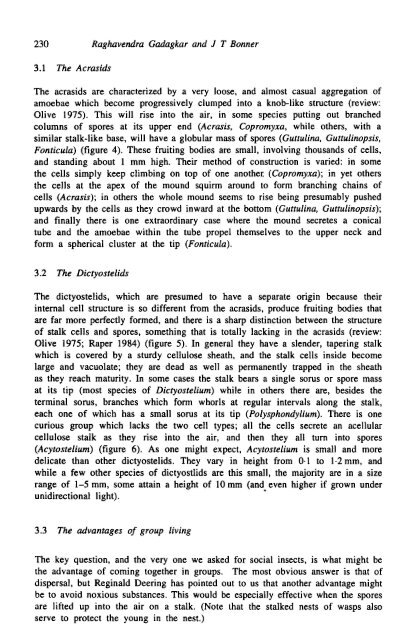Social insects and social amoebae. - Centre for Ecological Sciences
Social insects and social amoebae. - Centre for Ecological Sciences
Social insects and social amoebae. - Centre for Ecological Sciences
You also want an ePaper? Increase the reach of your titles
YUMPU automatically turns print PDFs into web optimized ePapers that Google loves.
230 Raghavendra Gadagkar <strong>and</strong> J T Bonner3.1 The AcrasidsThe acrasids are characterized by a very loose, <strong>and</strong> almost casual aggregation of<strong>amoebae</strong> which become progressively clumped into a knob-like structure (review:Olive 1975). This will rise into the air, in some species putting out branchedcolumns of spores at its upper end (A crasis, Cop romyxa , while others, with asimilar stalk-like base, will have a globular mass of spores (Guttulina, Guttulinopsis,Fonticula) (figure 4). These fruiting bodies are small, involving thous<strong>and</strong>s of cells,<strong>and</strong> st<strong>and</strong>ing about 1 mm high. Their method of construction is varied: in somethe cells simply keep climbing on top of one another: (Copromyxa); in yet othersthe cells at the apex of the mound squirm around to <strong>for</strong>m branching chains ofcells (Acrasis); in others the whole mound seems to rise being presumably pushedupwards by the cells as they crowd inward at the bottom (Guttulina, Guttulinopsis);<strong>and</strong> finally there is one extraordinary case where the mound secretes a conicaltube <strong>and</strong> the <strong>amoebae</strong> within the tube propel themselves to the upper neck <strong>and</strong><strong>for</strong>m a spherical cluster at the tip (Fonticula).3.2 The DictyostelidsThe dictyostelids, which are presumed to have a separate origin because theirinternal cell structure is so different from the acrasids, produce fruiting bodies thatare far more perfectly <strong>for</strong>med, <strong>and</strong> there is a sharp distinction between the structureof stalk cells <strong>and</strong> spores, something that is totally lacking in the acrasids (review:Olive 1975; Raper 1984) (figure 5). In general they have a slender, tapering stalkwhich is covered by a sturdy cellulose sheath, <strong>and</strong> the stalk cells inside becomelarge <strong>and</strong> vacuolate; they are dead as well as permanently trapped in the sheathas they reach maturity. In some cases the stalk bears a single sorus or spore massat its tip (most species of Dictyostelium) while in others there are, besides theterminal sorus, branches which <strong>for</strong>m whorls at regular intervals along the stalk,each one of which has a small sorus at its tip (Polysphondylium). There is onecurious group which lacks the two cell types; all the cells secrete an acellularcellulose stalk as they rise into the air, <strong>and</strong> then they all turn into spores(Acytostelium) (figure 6). As one might expect, Acytostelium is small <strong>and</strong> moredelicate than other dictyostelids. They vary in height from 0.1 to 1.2 mm, <strong>and</strong>while a few other species of dictyostlids are this small, the majority are in a sizerange of 1-5 mm, some attain a height of 10 mm (<strong>and</strong> even higher if grown underunidirectional light). .3.3 The advantages of group livingThe key question, <strong>and</strong> the very one we asked <strong>for</strong> <strong>social</strong> <strong>insects</strong>, is what might bethe advantage of coming together in groups. The most obvious answer is that ofdispersal, but Reginald Deering has pointed out to us that another advantage mightbe to avoid noxious substances. This would be especially effective when the sporesare lifted up into the air on a stalk. (Note that the stalked nests of wasps alsoserve to protect the young in the nest.)
















